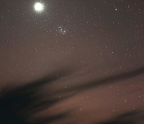THE INBETWEENERS

WE HUMANS LOVE to categorise things. Prior to the detection of planets beyond our Solar System, this was straightforward. The big ball of fusing hydrogen in the centre of the Solar System? A star, our Sun. The distant, giant, hydrogen-rich planets in the outer Solar System? Gas planets. The little spheres of rock like the one we call home? Terrestrial planets.
But as new objects are found, our neat categories become more and more messy. Much like the discovery of the Kuiper Belt led to the demotion of Pluto to its dwarf-planet status, as we find more objects outside the Solar System, we realise that many are not easily divided into the bins we initially chose.
Since the 1990s, astronomers have discovered thousands of objects that are neither stars nor planets, free-floating through space like stars but too low in mass to be considered stars. Scientists dutifully put them in another long-theorised category: brown dwarfs. But as we’ve discovered more brown dwarfs and exoplanets, researchers have noticed something quite interesting: The lowest-mass brown dwarfs and the highest-mass exoplanets can actually have the same masses! Suddenly the neat categories for dividing planets from stars have become much murkier… and so has our understanding of how they both form.
Between planets and stars
Brown dwarfs likely form the same way that stars do, collapsing from clouds of gas. The star-formation process most commonly makes stars significantly less massive than our own Sun. Above and below this most common mass, the number of stars dwindles. At the high-mass end, there are the massive, luminous blue stars, which catastrophically explode when they die. At the low-mass end, there are the brown dwarfs.
The more massive an object, the higher the energy of its formative gravitational collapse,
You’re reading a preview, subscribe to read more.
Start your free 30 days





